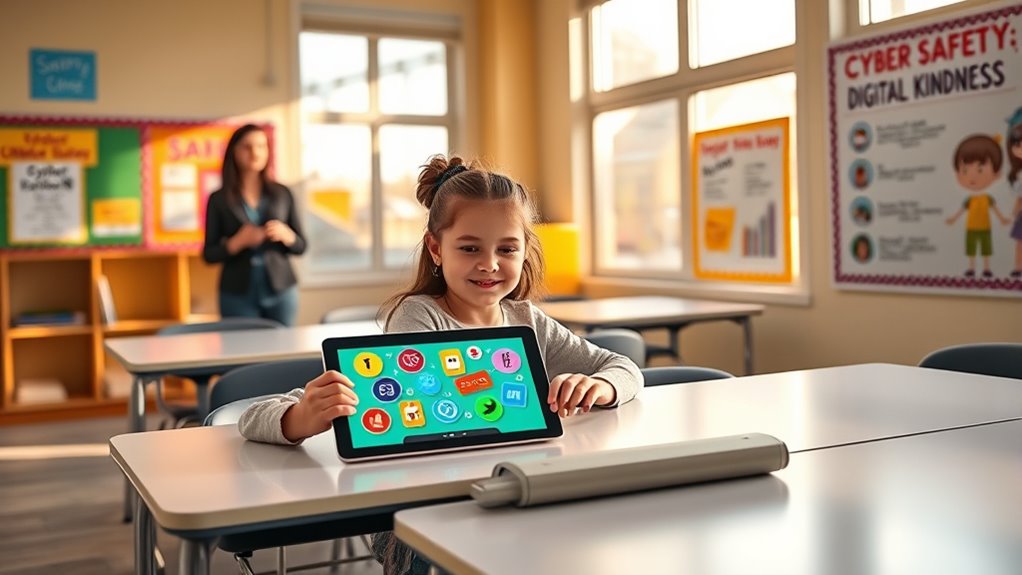Teaching kids good cyber hygiene means showing them simple habits that keep their online life safe without scaring them. Encourage practices like creating strong passwords, avoiding unknown links, and talking openly about online risks. Use positive language and focus on being proactive rather than fearful. When you promote awareness with a calm approach, your child learns to protect themselves confidently. Keep exploring, and you’ll discover more ways to help them stay secure and informed.
Key Takeaways
- Use positive language to teach kids about online safety, emphasizing empowerment rather than fear.
- Focus on simple, practical habits like strong passwords and recognizing suspicious links to build confidence.
- Incorporate engaging activities and stories to make cybersecurity lessons relatable and age-appropriate.
- Encourage open conversations where children feel comfortable sharing online experiences without judgment.
- Reinforce the importance of digital hygiene as a way to stay safe, not as a list of restrictions or scare tactics.

Have you ever wondered how kids can stay safe online? Just like personal hygiene helps keep your body healthy, cyber hygiene involves daily habits that protect your devices and personal information from cyber threats. It’s about practicing simple, effective steps to stay secure, such as updating software regularly, creating strong passwords, and staying aware of potential dangers. When you follow good cyber hygiene, you’re not just safeguarding your own data—you’re also helping protect your school’s network and other students’ information. This proactive approach reduces the chances of falling victim to malware, phishing scams, or hacking attempts, which are common risks today.
Practicing good cyber hygiene protects your devices and keeps online information safe.
Kids are especially vulnerable because they often interact with strangers online. Studies show that 40% of students in grades 4 to 8 have communicated with someone they don’t know personally. Many are unaware of the risks, making them easy targets for cybercriminals. Schools face a high volume of cyber threats too—about 80% of malicious activity targets educational institutions, and nearly all schools have experienced some form of cyberattack. These attacks can lead to serious issues like cyberbullying, identity theft, or malware infections that disrupt learning and compromise sensitive information.
As education becomes more digital, understanding cyber hygiene becomes essential. Schools rely on digital tools and devices, which students often use for homework, projects, or communication. When students practice good cyber hygiene, they help prevent disruptions caused by data breaches or malware. Educating students on safe online behaviors empowers them to protect themselves and their peers, fostering a culture of awareness and responsibility. For instance, knowing to avoid clicking unknown links or downloading suspicious attachments can prevent malware infections. Using strong, unique passwords and enabling two-factor authentication add extra layers of security. Backing up important data regularly ensures that even if an attack occurs, valuable information isn’t lost. Cyber hygiene is especially critical as the rise in cyber threats targeting educational sectors continues to grow rapidly. Implementing security best practices helps create a safer digital environment for everyone involved.
Parents and schools play important roles in this effort. Schools should incorporate cyber hygiene lessons into their curricula and enforce device usage policies. Parents need to monitor their children’s online activities and have open conversations about digital safety. When everyone works together—teachers, parents, and IT staff—it creates a united front against cyber threats. Encouraging open dialogue about online experiences helps children recognize and report suspicious activity early, making cybersecurity a shared responsibility.
Practicing good cyber hygiene doesn’t mean living in fear of cyber threats. Instead, it’s about building habits that keep everyone safer online. By staying vigilant, updating devices, and practicing common-sense online behaviors, you can enjoy the benefits of digital learning while minimizing risks. Teaching kids these habits early prepares them for a safer online future—where they can navigate the digital world confidently and securely.
Frequently Asked Questions
How Can Parents Monitor Kids’ Online Activity Effectively?
You can monitor your kids’ online activity effectively by combining technology and direct engagement. Use parental control apps to block inappropriate content and set time limits. Regularly check their websites, social media profiles, and messages to stay informed. Have open conversations about online safety, creating a balance between supervision and trust. Staying involved and setting clear rules helps protect them without making them feel overly restricted.
What Are Age-Appropriate Digital Safety Tools Available?
You want to know about age-appropriate digital safety tools. For young kids, use simple educational apps with strict filters and supervised device placement. As they grow, utilize parental control software like Kaspersky Safe Kids, set screen time, and filter content. For preteens and teens, introduce privacy settings, monitor online interactions, and encourage open conversations. These tools help create a safe digital environment tailored to each age group’s needs.
How to Handle Cyberbullying Without Scaring Children?
When handling cyberbullying, you want to keep your child calm and supported. Use open-ended, age-appropriate conversations to discuss their feelings and experiences without causing fear. Reassure them they’re not to blame and that help is available. Teach resilience by showing them how to ignore or report hurtful comments, and involve trusted adults. Focus on building their confidence and understanding of online safety, so they feel empowered rather than scared.
When Should Kids Be Allowed to Have Social Media Accounts?
You might wonder when kids should get social media accounts. Did you know that 53% of 11-year-olds already have one? Experts suggest waiting until middle school, around eighth grade, for better supervision. This way, you can guide responsible use, set clear rules, and teach your child about online safety. Starting earlier can lead to less oversight and more risks, so it’s best to introduce social media with your support and open communication.
How to Encourage Responsible Online Sharing Behaviors?
To encourage responsible online sharing, set clear boundaries about what personal info can be shared, emphasizing the risks of oversharing. Monitor their online interactions actively, using privacy settings to limit exposure. Talk openly about red flags like inappropriate messages or grooming attempts, and foster a safe space where they feel comfortable reporting concerns. Educate them on digital literacy, helping them understand the importance of critical thinking and responsible behavior online.
Conclusion
Think of teaching kids about digital safety like planting a garden. With regular care and attention, your child’s online habits grow strong and resilient. Just last year, a study showed that kids with good cyber hygiene are 50% less likely to fall for scams. By guiding them calmly and confidently, you help them build a safe digital space—like nurturing a garden that flourishes, free from weeds of fear or misinformation. Your effort today keeps their online world healthy tomorrow.








